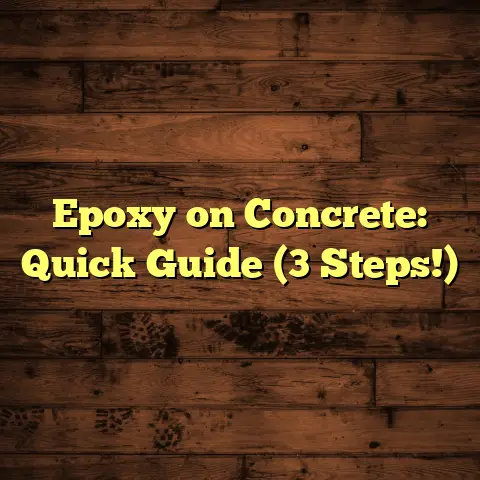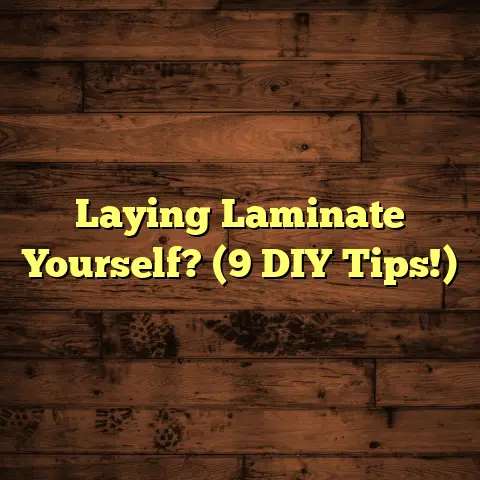Sealing Basement Floor for Radon? (5 Safety Steps!)
Radon is a naturally occurring radioactive gas that you can’t see, smell, or taste.
It comes from the breakdown of uranium in soil, rock, and water.
Now, you might be thinking, “Radioactive gas?
That sounds scary!” And you’re right, it can be.
Long-term exposure to radon is the second leading cause of lung cancer in the United States, according to the EPA.
(Source: EPA Radon Information)
But don’t panic!
The good news is that radon issues can be addressed, especially in basements where the gas loves to accumulate.
Think of your basement like a cozy little cave for radon.
Cracks in the foundation, gaps around pipes, and even porous concrete can act as entry points.
That’s where sealing your basement floor comes in.
It’s like building a shield against this invisible threat.
But here’s the thing: we’re not just talking about any old sealant.
We’re talking about eco-tech solutions – environmentally friendly materials and methods that not only block radon but also promote sustainability.
I’ve seen a growing trend towards eco-conscious living, and it’s fantastic!
People are realizing that home safety and health don’t have to come at the expense of the environment.
We can have both!
Why is this so important?
Well, according to the National Cancer Institute, approximately 20,000 lung cancer deaths each year in the U.S.
are related to radon.
That’s a staggering number!
But the encouraging part is that sealing techniques, when done correctly, can significantly reduce radon levels.
In fact, the EPA estimates that radon mitigation measures can reduce radon levels by as much as 99%.
So, buckle up, because we’re about to embark on a journey to understand radon, learn why sealing your basement floor is crucial, explore eco-tech solutions, and, most importantly, walk through the 5 essential safety steps to get the job done right.
Let’s make your home a safer, healthier, and more eco-friendly space!
Section 1: Understanding Radon
Okay, let’s get down to the nitty-gritty of radon.
What exactly is this stuff, and why should we care?
As I mentioned earlier, radon is a naturally occurring radioactive gas.
It’s formed when uranium breaks down in the soil, rocks, and water.
It’s part of the Earth’s natural radioactive decay process.
Now, here’s the geological side of things.
Radon gas can seep through the ground and into buildings through cracks in the foundation, gaps around pipes, and other openings.
Think of it like water finding its way through the smallest cracks in a dam.
Why is this a concern for homeowners?
Well, when radon enters your home, it can accumulate, especially in poorly ventilated areas like basements.
And that’s where the health risks come into play.
The EPA and the World Health Organization (WHO) have established guidelines for acceptable radon levels in homes.
The EPA recommends taking action to reduce radon levels if they are at or above 4 picocuries per liter (pCi/L).
The WHO recommends a reference level of 100 Bq/m3 (2.7 pCi/L) to minimize health risks.
But what does radon exposure actually do to you?
Well, when you breathe in radon, it can damage the cells in your lungs.
Over time, this can lead to lung cancer.
It’s a long-term risk, but it’s a serious one.
I remember one case I worked on a few years back.
A family had lived in their home for over 20 years, completely unaware of the high radon levels in their basement.
The husband was diagnosed with lung cancer, and it turned out that radon exposure was a significant contributing factor.
It was a wake-up call for the entire community.
I’ve also seen cases where families were proactive and tested their homes, found elevated radon levels, and took steps to mitigate the problem.
They were able to protect their health and their peace of mind.
The moral of the story?
Don’t ignore radon.
Understand the risks, get your home tested, and take action if necessary.
It’s a simple step that can make a huge difference in your health and well-being.
Section 2: The Importance of Sealing Basement Floors
So, we know radon is bad news. But why focus on sealing basement floors?
Well, your basement floor is often the primary entry point for radon gas into your home.
Think of it as a welcome mat for this invisible intruder.
Unsealed concrete floors are porous, meaning they have tiny holes and cracks that allow radon to seep through.
Even if your floor looks solid, there can be microscopic pathways that radon can exploit.
Gaps around pipes, cracks in the foundation, and even the joint where the floor meets the walls can all be entry points.
When radon enters through these openings, it can accumulate in your basement, creating a concentrated source of exposure.
Sealing your basement floor creates a barrier that prevents radon from entering your home in the first place.
It’s like putting up a shield to deflect the radon attack.
But the benefits of sealing go beyond just radon mitigation.
Sealing can also improve your indoor air quality by reducing the amount of moisture and mold that can accumulate in your basement.
A dry basement is a healthier basement!
It can also enhance your home’s energy efficiency by reducing air leaks and drafts.
This can lead to lower energy bills and a more comfortable living environment.
And let’s not forget about property value!
A home with a sealed basement is generally more attractive to potential buyers.
It shows that you’ve taken steps to protect the home and maintain its value.
I often use diagrams to explain this to my clients.
Imagine your basement floor as a sponge.
Without sealing, it soaks up radon from the ground and releases it into your home.
Sealing is like coating that sponge with a waterproof layer, preventing it from absorbing radon.
It’s a simple visual that helps people understand the concept.
The effectiveness of sealing can vary depending on the type of sealant used, the condition of the floor, and the quality of the application.
But in general, sealing can significantly reduce radon levels, often by 50% or more.
It’s not a magic bullet, but it’s a crucial step in creating a safer and healthier home.
If you’re serious about radon mitigation, sealing your basement floor is a must.
It’s an investment in your health, your home, and your peace of mind.
Section 3: Eco-Tech Solutions for Sealing
Alright, let’s talk about the exciting part: eco-tech solutions for sealing your basement floor!
In today’s world, we’re not just looking for effective solutions; we’re also looking for environmentally friendly ones.
And when it comes to sealing your basement, there are some fantastic eco-conscious options available.
One of the key things to look for is low-VOC (volatile organic compound) products.
VOCs are chemicals that can be released into the air and contribute to indoor air pollution.
Low-VOC sealants minimize this risk, creating a healthier living environment.
Biodegradable sealants are another great option.
These sealants are made from renewable resources and break down naturally over time.
They’re a more sustainable choice compared to traditional sealants that are made from petroleum-based products.
You can also look for sealants that are made from recycled materials.
This helps reduce waste and conserve resources.
Some companies are even using innovative materials like bio-based polymers to create eco-friendly sealants.
I’ve been particularly impressed with products from companies like Eco Building Products and Green Building Supply.
They offer a range of sealants that are both effective and environmentally responsible.
When you’re shopping for eco-friendly sealants, look for certifications like Green Seal, GREENGUARD, or LEED.
These certifications indicate that the product has been tested and meets certain environmental standards.
How do these eco-tech solutions contribute to a healthier living environment?
Well, they reduce the risk of exposure to harmful chemicals, improve indoor air quality, and promote sustainability.
They also align with the growing trend of eco-conscious living, where people are making choices that benefit both their health and the environment.
I’ve seen a shift in the industry towards more sustainable practices.
More and more manufacturers are developing eco-friendly products, and consumers are demanding them.
It’s a win-win situation!
Choosing eco-tech solutions for sealing your basement floor is not just good for your health; it’s also good for the planet.
You can create a safer, healthier, and more sustainable home without compromising on performance.
It’s a smart choice that you can feel good about.
Section 4: 5 Safety Steps for Sealing Basement Floors
Okay, now for the main event: the 5 essential safety steps for sealing your basement floor against radon!
This is where we get practical and walk through the process step by step.
Step 1: Assessing the Basement Environment
Before you even think about sealing, you need to know if you have a radon problem in the first place.
The only way to know for sure is to test your basement for radon.
You can purchase a DIY radon testing kit at most hardware stores or online.
These kits are relatively inexpensive and easy to use.
Follow the instructions carefully, and be sure to place the test kit in the lowest level of your home, preferably in an area where you spend a lot of time.
You can also hire a professional radon testing company to perform the test for you.
This is a more accurate option, but it’s also more expensive.
If your radon levels are at or above 4 pCi/L, you should take action to reduce them.
This is where sealing your basement floor comes in.
Step 2: Preparing the Area
Before you can apply any sealant, you need to prepare the area.
This means cleaning the floor thoroughly to remove any dirt, dust, debris, or old paint.
Use a broom, vacuum, and a scrub brush to get the floor as clean as possible.
You may also need to use a degreaser to remove any oil or grease stains.
If there are any cracks or holes in the floor, fill them with a concrete patching compound.
Allow the patching compound to dry completely before proceeding.
Proper ventilation is crucial during the sealing process.
Open windows and doors to allow fresh air to circulate.
You can also use a fan to help ventilate the area.
Wear a respirator mask to protect yourself from dust and fumes.
Step 3: Choosing the Right Eco-Friendly Sealant
Now it’s time to choose the right sealant.
As we discussed earlier, look for low-VOC, biodegradable, or recycled sealants.
Read the product labels carefully to make sure the sealant is suitable for use on concrete floors and that it’s effective at blocking radon.
Consider the size of your basement and the amount of sealant you’ll need.
It’s always better to buy a little extra than to run out in the middle of the job.
Check the sealant’s drying time and application instructions.
Some sealants require multiple coats, while others can be applied in a single coat.
Choose a sealant that you’re comfortable working with and that fits your schedule.
Step 4: Applying the Sealant
Now for the fun part: applying the sealant!
Start by reading the manufacturer’s instructions carefully.
Each sealant is different, so it’s important to follow the instructions to ensure proper application.
Use a paint roller or a brush to apply the sealant to the floor.
Work in small sections, and be sure to apply an even coat.
Pay special attention to cracks, gaps, and joints.
You may need to use a brush to get into these tight spaces.
If the sealant requires multiple coats, allow each coat to dry completely before applying the next coat.
The drying time will vary depending on the sealant and the humidity.
Once you’ve applied all the coats, allow the sealant to dry completely before walking on the floor.
This may take several hours or even a day or two.
Step 5: Post-Sealing Monitoring and Maintenance
After you’ve sealed your basement floor, it’s important to monitor the radon levels to make sure the sealing was effective.
Test your basement for radon again a few weeks after sealing.
If the radon levels are still elevated, you may need to take additional steps to reduce them, such as installing a radon mitigation system.
Regularly inspect your sealed floor for cracks or damage.
If you find any, repair them promptly to maintain the effectiveness of the sealant.
Clean your sealed floor regularly with a mild detergent and water.
Avoid using harsh chemicals or abrasive cleaners, as these can damage the sealant.
By following these five safety steps, you can effectively seal your basement floor against radon and create a safer, healthier home.
Remember, safety is always the top priority.
Wear protective gear, ventilate the area properly, and follow the manufacturer’s instructions carefully.
With a little effort and the right eco-tech solutions, you can breathe easier knowing that you’ve taken a proactive step to protect your health and the environment.
Section 5: Conclusion
We’ve covered a lot of ground in this article, from understanding the dangers of radon to exploring eco-tech solutions for sealing your basement floor.
Let’s recap the key points:
- Radon is a naturally occurring radioactive gas that can cause lung cancer.
- Basement floors are often the primary entry point for radon into your home.
- Sealing your basement floor can significantly reduce radon levels.
- Eco-tech solutions offer effective and environmentally friendly sealing options.
- Following the five safety steps is crucial for a successful sealing project.
Sealing your basement floor is an investment in your health, your home, and the environment.
It’s a proactive step that can protect you and your family from the harmful effects of radon exposure.
By choosing eco-tech solutions, you can also contribute to a more sustainable future.
I encourage you to evaluate your own basement and consider sealing as a vital step in protecting your health and the environment.
Don’t wait until it’s too late.
Take action today to create a safer, healthier home for yourself and your loved ones.
Test your basement for radon, research eco-friendly sealants, and follow the five safety steps.
You’ll be amazed at the difference it can make.
Remember, your home is your sanctuary.
Let’s make it a safe and healthy place to live, one sealed basement floor at a time!
If you have any questions or need further assistance, don’t hesitate to reach out to a qualified flooring contractor or radon mitigation specialist.
They can provide expert advice and help you choose the best solutions for your specific needs.
Thank you for joining me on this journey to a safer, healthier, and more eco-friendly home.
Together, we can make a difference!





